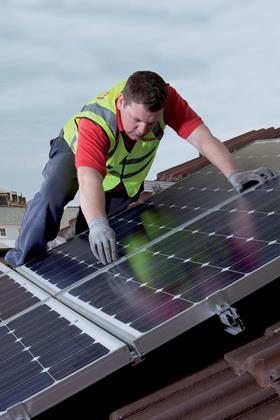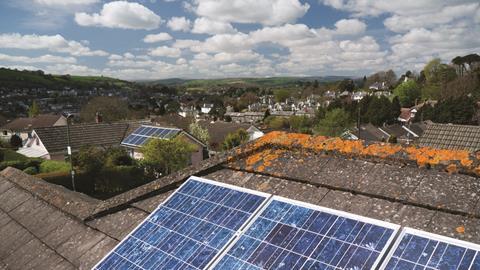Photovoltaic panels are becoming ever more numerous as prices drop, but they can be a heavy burden on your roof if not carefully installed, says Peter Caplehorn
The feed-in tariff and falling costs of PV panels mean that almost every street in the country now has a PV installation. The number of installations has fallen dramatically since the recent cuts in the feed in tariff as everyone tried to beat the deadline but as the cost of PV has fallen by up to 30% over the past year, and will continue to drop, demand should start creeping up again.
Anyone considering PV panels should look beyond the capital cost and payback periods to the impact the installation could have on their roof. The first issue to consider is the additional loads that the panels will impose.

The average panel weighs in at around 15kg per square metre. This is in addition to the weight of the most popular tiles that come in at between 30kg and 60kg per square metre. This means that the dead load increase is significant and while not immediately dangerous raises a few concerns when other forces are taken in to account.
As well as the additional dead load, there are lateral wind forces and uplift to take into account. The positioning of many installations creates a cavity below the panels which is open on all sides. This creates perfect conditions for wind to gust in and generate uplift.
Equally the general arrangement provides a place for snow and ice to lodge which can build up significantly, leading to additional loading issues and may result in a dangerous mass when it eventually falls off.
Every existing roof will present a different installation situation. Many thousands of relatively modern roofs use trussed rafters that are finely engineered to maximise the balance of strength and economy. While these can undoubtedly take the extra load what possibly is not taken account is the quality of the original build and the wear
and tear since the home was built. The extra stresses that the installation poses need to be reviewed by a structural engineer or roofing specialist.
Equally while older roofs may be less finely engineered and therefore potentially more robust because of the quality of the timber and craftsmanship, they are more likely to have become weakened through age. The handmade nature of older roofs also means it may be harder to find easy, predicable fixing centres.
Given manufacturers are claiming a 25-year life for the panels, it would seem intermittent safety examinations on the structure may not be a bad thing, in addition to the check carried out for initial installation. Installers should also consider compliance with building regulations, specifically Part A which covers structures.
A delicate process
Most common roof finishes are not only relatively heavy but also easy to damage. Damage during installation is a real concern, especially as a lot of the roof is hidden when the array is complete. Additionally there is the need for the fixings and the electrical connections to be weatherproof. Flashings that keep the water out in all weather conditions are often the weakest point in any traditional roof. Also, the average array of six to 10 panels will have a series of connection points. Each fixing must run back to the structure and feature a proper flashing detail without exerting any extra pressure on the roof finish itself.
All modern roofs also use a breather membrane under the tiles. This can catch any moisture that may get through the tiles and also has to be penetrated by the panel fixings, providing a point for water ingress. This must be flashed correctly to stop water getting in.
The panels need an occasional clean and for most installations this will be relatively easy to do with the right safety precautions. It should be borne in mind that even a small amount of dirt on the top surface can cut the performance between 5-8%.
Additionally, the cavity below the panels is an ideal place for debris and dirt to collect and this is difficult to prevent. This can have a harmful effect on the roof finish by encouraging moss and lichen growth, which will have a detrimental effect on the tiles. This is all concealed from view and in most cases is very difficult to access. Closing the cavity beneath the panels could make the long-term effects worse as this will cut off the air flow.

Solutions
Periodic jet washing can help remove the debris but this needs to be done from the top, necessitating expensive and complex access equipment. Fully integrated panels as part of the roof is the best answer but this has its own problems, including committing to a specific panel type when the technology is changing rapidly.
Roof access is also a difficult issue to reconcile as most installations cover the useable area of the roof to maximise electrical output. This leaves very little room around the roof perimeter for maintenance access. A cause for particular concern is the emergence of micro-inverters that are fixed behind each panel, making maintenance access potentially very difficult and dangerous, particularly for panels in the centre of an array. Specialist roofing ladders that can span over the panels and provide a safe working platform are needed.
As the industry develops, it is clear that techniques and methods will mature to take account of these issues. Until this happens, and particularly with the Green Deal about to encourage us to add more solar panels on our roofs, we should all be aware of the checks and balances that need to be in place for our own future peace of mind.
Peter Caplehorn is technical director at architect Scott Brownrigg




























No comments yet